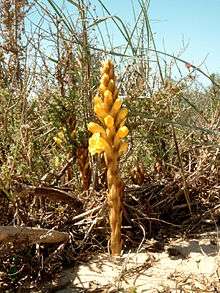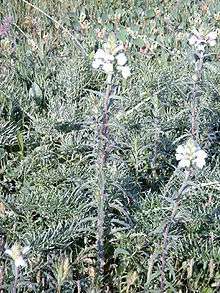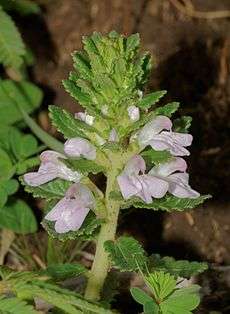Orobanchaceae
Orobanchaceae, the broomrapes, is a family of mostly parasitic plants of the order Lamiales, with about 90 genera and more than 2000 species.[3] Many of these genera (e.g., Pedicularis, Rhinanthus, Striga) were formerly included in the family Scrophulariaceae sensu lato.[4][5][6] With its new circumscription, Orobanchaceae forms a distinct, monophyletic family.[6] From a phylogenetic perspective, it is defined as the largest crown clade containing Orobanche major and relatives, but neither Paulownia tomentosa nor Phryma leptostachya nor Mazus japonicus.[7][8]
| Orobanchaceae | |
|---|---|
 | |
| Striga bilabiata | |
| Scientific classification | |
| Kingdom: | Plantae |
| Clade: | Tracheophytes |
| Clade: | Angiosperms |
| Clade: | Eudicots |
| Clade: | Asterids |
| Order: | Lamiales |
| Family: | Orobanchaceae Vent.[1] |
| Tribes[2] | |
| |
The Orobanchaceae are annual herbs or perennial herbs or shrubs, and all (except Lindenbergia, Rehmannia and Triaenophora) are parasitic on the roots of other plants—either holoparasitic or hemiparasitic (fully or partly parasitic). The holoparasitic species lack chlorophyll and therefore cannot perform photosynthesis.

_Negev.jpg)


Distribution
The family Orobanchaceae has a cosmopolitan distribution, found mainly in temperate Eurasia, North America, South America, parts of Australia, New Zealand, and tropical Africa. The only exception to its distribution is Antarctica, though some genera may be found in subarctic regions.[9]
Life history traits
Orobanchaceae is the largest of the 20–28 dicot families that express parasitism.[10] Apart from a few non-parasitic taxa, the family displays all types of plant parasitism: facultative parasite, obligate parasite, hemiparasites, and holoparasites.
Characteristics
Roots and stems
Parasitic plants are attached to their host by means of haustoria, which transfer nutrients from the host to the parasite. Only the hemiparasitic species possess an additional extensive root system referred to as the lateral or side haustoria. In most holoparasitic species there is a swollen mass of short, bulky roots or one big swollen haustorial organ, which may be simple or composite, commonly called the terminal or primary haustorium.[11]
Plants are reduced to short vegetative stems, their alternate leaves are reduced to fleshy, tooth-like scales, and have multicellular hairs interspersed with glandular hairs.[12]
The hemiparasitic species (transferred from Scrophulariaceae) with green leaves are capable of photosynthesis, and may be either facultative or obligate parasites.
Flowers
The hermaphroditic flowers are bilaterally symmetrical and grow either in racemes or spikes or singly at the apex of the slender stem. The tubular calyx is formed by 2–5 united sepals. There are five united, bilabiate petals forming the corolla and they may be yellowish, brownish, purplish, or white. The upper lip is two-lobed, the lower lip is three-lobed. There are two long and two short stamens on slender filaments, inserted below the middle, or at the base of the corolla tube, alternating with the lobes of the tube. A fifth stamen is either sterile or lacking completely. The anthers dehisce via longitudinal slits. The pistil is one-celled. The ovary is superior. The flowers are pollinated by insects or birds (e.g. hummingbirds, as in Castilleja).
Fruits
The fruit is a dehiscent, non-fleshy, 1-locular capsule with many very minute endospermic seeds. Fruits of Orobanchaceae are small and abundant and can produce between 10,000–1,000,000 seeds per plant.[13] These are dispersed by the wind over long distances, which increases their chances of finding a new host.
Evolution
Development of the haustoria was a significant evolutionary event that allowed for the advancement of parasitic plants. The holoparasitic clade, Orobanche, delineates the first transition from hemiparasitism to holoparasitism within Orobanchaceae.
Despite the similar morphological traits found in both Scrophulariaceae and Orobanchaceae, the latter is now morphologically and molecularly considered monophyletic, though many of its genera were once considered a part of the family Scrophulariaceae.
Lindenbergia, once treated as a member of the Scrophulariaceae, is the one of the only autotrophic genera within Orobanchaceae. It is believed to be the sister group to the hemiparasitic genera within its family.[14]
Genomics
The parasitism and its different modes have been suggested to have an impact on genome evolution, with increased DNA substitution rates in parasitic organisms compared to non-parasitic taxa.[15] For example, holoparasite taxa of Orobanchaceae exhibit faster molecular evolutionary rates than confamilial hemiparasites in three plastid genes.[16]
In a study comparing the rates of molecular evolution of parasitic versus non parasitic taxa for 12 pairs of angiosperm families — including Apodanthaceae, Cytinaceae, Rafflesiaceae, Cynomoriaceae, Krameriaceae, Mitrastemonaceae, Boraginaceae, Orobanchaceae, Convolvulaceae, Lauraceae, Hydnoraceae, and Santalaceae/Olacaceae —, parasitic taxa evolve on average faster than their close relatives for mitochondrial, plastid, and nuclear genome sequences.[17] Whereas Orobanchaceae fit to this trend for plastid DNA, they appear to evolve slower than their non parasitic counterpart in comparisons involving nuclear and mitochondrial DNA.[17]
Ecology
This family has tremendous economic importance because of the damage to crops caused by some species in the genera Orobanche and Striga. They often parasitize cereal crops like sugarcane, maize, millet, sorghum, and other major agricultural crops like cowpea, sunflower, hemp, tomatoes, and legumes. Because of the ubiquitous nature of these particular parasites in developing countries, it is estimated to affect the livelihood of over 100 million people, killing 20 to 100 percent of crops depending on infestation.[18]
Some genera, especially Cistanche and Conopholis, are threatened by human activity, including habitat destruction and over-harvesting of both the plants and their hosts.
Research for this plant family can often be difficult due to its permit requirements for collection, travel, and research.
Taxonomy
Orobanchaceae comprises the following genera, listed according to their life history trait.
- Bartsiella
- Bornmuellerantha
- Brachystigma
- Brandisia
- Cyclocheilon
- Kopsiopsis
- Macrosyringion
- Odontiella
Non-parasitic
- Lindenbergia
- Rehmannia [lower-alpha 1]
- Triaenophora
Hemiparasitic
- Agalinis
- Alectra
- Asepalum
- Aureolaria
- Bartsia
- Bellardia
- Buchnera
- Bungea
- Buttonia
- Castilleja : Indian paintbrush
- Centranthera
- Clevelandia
- Cordylanthus : Bird's-beak
- Cycnium
- Cymbaria
- Dasistoma
- Escobedia
- Esterhazya
- Euphrasia
- Gerardiina
- Ghikaea
- Graderia
- Hedbergia
- Lamourouxia
- Leptorhabdos
- Leucosalpa
- Macranthera
- Magdalenaea
- Melampyrum
- Melasma
- Micrargeria
- Micrargeriella
- Monochasma
- Nesogenes
- Nothobartsia
- Nothochilus
- Odontites
- Omphalotrix
- Ophiocephalus
- Orthocarpus
- Parastriga
- Parentucellia
- Pedicularis
- Petitmenginia
- Phtheirospermum
- Physocalyx
- Pseudobartsia
- Pseudomelasma
- Pseudosopubia
- Pseudostriga
- Pterygiella
- Radamaea
- Rhamphicarpa
- Rhaphispermum
- Rhinanthus
- Rhynchocorys
- Schwalbea
- Seymeria
- Sieversandreas
- Silviella
- Siphonostegia
- Sopubia
- Spirostegia
- Striga
- Tetraspidium
- Thunbergianthus
- Tozzia
- Triphysaria
- Vellosiella
- Xizangia
- Xylocalyx
Holoparasitic
- Aeginetia
- Boschniakia : Groundcone
- Christisonia
- Cistanche: Desert broomrape [lower-alpha 2]
- Conopholis : Cancer-root
- Epifagus : Beechdrops
- Eremitilla
- Gleadovia
- Harveya
- Hyobanche
- Lathraea
- Mannagettaea
- Orobanche : Broomrape
- Phacellanthus
- Phelypaea
- Platypholis
- Tienmuia
| Wikimedia Commons has media related to Orobanchaceae. |
Notes
- Sometimes placed outside of Orobanchaceae as a sister-taxon.
- Rou cong rong, (Chinese: 肉苁蓉, pinyin ròucongróng).
References
- Angiosperm Phylogeny Group (2009). "An update of the Angiosperm Phylogeny Group classification for the orders and families of flowering plants: APG III" (PDF). Botanical Journal of the Linnean Society. 161 (2): 105–121. doi:10.1111/j.1095-8339.2009.00996.x. Retrieved 2013-07-06.
- Stevens, Peter. "Angiosperm Phylogeny Website, version 13. Lamiales: Orobanchaceae". www.mobot.org. Retrieved 20 December 2016.
- McNeal, J. R.; Bennett, J. R.; Wolfe, A. D.; Mathews, S. (2013-05-01). "Phylogeny and origins of holoparasitism in Orobanchaceae". American Journal of Botany. 100 (5): 971–983. doi:10.3732/ajb.1200448. ISSN 0002-9122. PMID 23608647.
- dePamphilis, Claude W.; Young, Nelson D.; Wolfe, Andrea D. (1997-07-08). "Evolution of plastid gene rps2 in a lineage of hemiparasitic and holoparasitic plants: Many losses of photosynthesis and complex patterns of rate variation". Proceedings of the National Academy of Sciences. 94 (14): 7367–7372. Bibcode:1997PNAS...94.7367D. doi:10.1073/pnas.94.14.7367. ISSN 0027-8424. PMC 23827. PMID 9207097.
- Young, Nelson D.; Steiner, Kim E.; dePamphilis, Claude W. (1999). "The Evolution of Parasitism in Scrophulariaceae/Orobanchaceae: Plastid Gene Sequences Refute an Evolutionary Transition Series". Annals of the Missouri Botanical Garden. 86 (4): 876. doi:10.2307/2666173. JSTOR 2666173.
- Olmstead, Richard G.; Pamphilis, Claude W. de; Wolfe, Andrea D.; Young, Nelson D.; Elisons, Wayne J.; Reeves, Patrick A. (2001). "Disintegration of the Scrophulariaceae". American Journal of Botany. 88 (2): 348–361. doi:10.2307/2657024. ISSN 1537-2197. JSTOR 2657024.
- Xia, Zhi; Wang, Yin-Zheng; Smith, James F. (2009). "Familial placement and relations of Rehmannia and Triaenophora (Scrophulariaceae s.l.) inferred from five gene regions". American Journal of Botany. 96 (2): 519–530. doi:10.3732/ajb.0800195. ISSN 1537-2197. PMID 21628207.
- Tank, David C.; Wolfe, Andrea; Mathews, Sarah; Olmstead, Richard G. (2020-04-30). "Orobanchaceae E. P. Ventenant 1799:292 [D. C. Tank, A. D. Wolfe, S. Mathews, and R. G. Olmstead], converted clade name". In de Queiroz, Kevin; Cantino, Philip D.; Gauthier, Jacques A. (eds.). Phylonyms: A Companion to the PhyloCode. CRC Press. pp. 1749–1751. ISBN 978-0-429-82120-2.
- Watson, David M. (October 13, 2009). "Parasitic plants as facilitators: more Dryad than Dracula?". Journal of Ecology. 97 (6): 1151–1159. doi:10.1111/j.1365-2745.2009.01576.x.
- editors, Daniel M. Joel, Jonathan Gressel, Lytton J. Musselman; Kebab, E. (2013). Parasitic orobanchaceae parasitic mechanisms and control strategies. Berlin: Springer. ISBN 978-3-642-38146-1.CS1 maint: extra text: authors list (link)
- Westwood, James H.; Yoder, John I.; Timko, Michael P.; dePamphilis, Claude W. (1 April 2010). "The evolution of parasitism in plants". Trends in Plant Science. 15 (4): 227–235. doi:10.1016/j.tplants.2010.01.004. ISSN 1878-4372. PMID 20153240.
- Young, N.D.; Steiner, K.E.; Claude, W. (1999). "The Evolution of Parasitism in Schrophulariaceae/Orobanchaceae: Plastid gene sequences refute an evolutionary transition series" (PDF). Annals of the Missouri Botanical Garden. 86 (4): 876–893. doi:10.2307/2666173. JSTOR 2666173.
- Molau, U. (1995). Parasitic Plants: Reproductive ecology and biology. London: Chapman and Hall. pp. 141–176.
- Judd, Walter S.; et al. (2008). Plant systematics : a phylogenetic approach (3rd ed.). Sunderland, Mass.: Sinauer Associates. ISBN 978-0-87893-407-2.
- Haraguchi, Yoshihiro; Sasaki, Akira (1996-11-21). "Host–Parasite Arms Race in Mutation Modifications: Indefinite Escalation Despite a Heavy Load?". Journal of Theoretical Biology. 183 (2): 121–137. doi:10.1006/jtbi.1996.9999. ISSN 0022-5193. PMID 8977873.
- Young, Nelson D.; dePamphilis, Claude W. (2005-02-15). "Rate variation in parasitic plants: correlated and uncorrelated patterns among plastid genes of different function". BMC Evolutionary Biology. 5 (1): 16. doi:10.1186/1471-2148-5-16. ISSN 1471-2148. PMC 554776. PMID 15713237.
- Bromham, Lindell; Cowman, Peter F.; Lanfear, Robert (1 January 2013). "Parasitic plants have increased rates of molecular evolution across all three genomes". BMC Evolutionary Biology. 13: 126. doi:10.1186/1471-2148-13-126. ISSN 1471-2148. PMC 3694452. PMID 23782527.
- Westwood, James H.; dePamphilis, Claude W.; Das, Malay; Fernández-Aparicio, Mónica; Honaas, Loren A.; Timko, Michael P.; Wafula, Eric K.; Wickett, Norman J.; Yoder, John I. (April–June 2012). "The Parasitic Plant Genome Project: New Tools for Understanding the Biology of Orobanche and Striga". Weed Science. 60 (2): 295–306. doi:10.1614/WS-D-11-00113.1. ISSN 0043-1745.